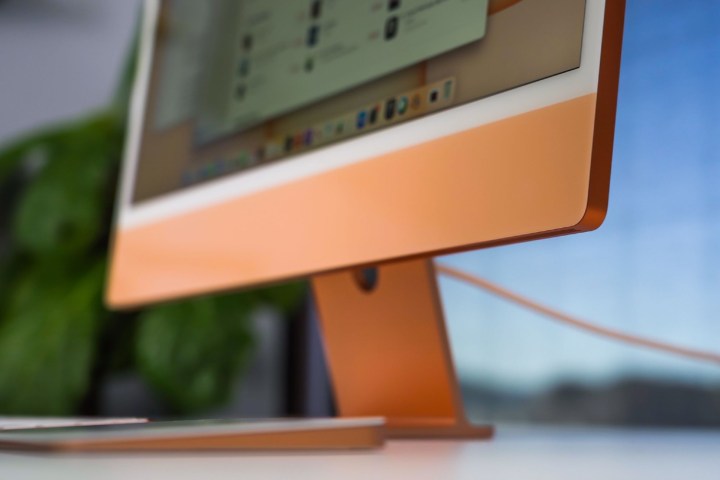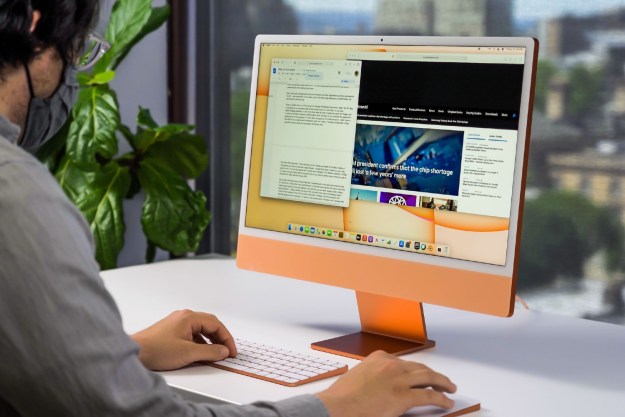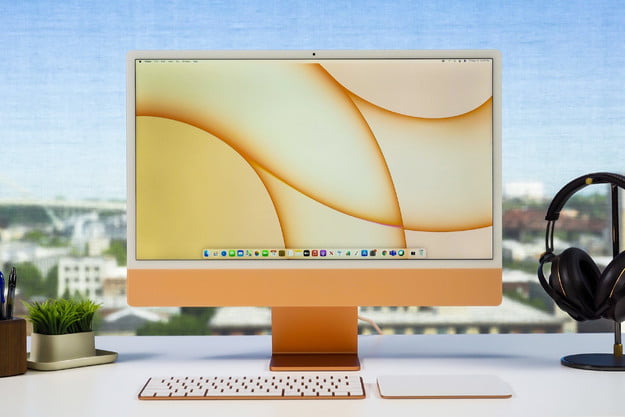
“The 24-inch iMac redefines the Mac for a new generation, and it has to be seen in person to be truly appreciated.”
- Eye-popping screen
- Speakers sound amazing
- Webcam is excellent
- M1 performance still surprises
- Lots of fun color options
- Touch ID built into keyboard
- Lame port selection
- The Magic Mouse is still annoying
Editor’s Note: The M1 iMac has been replaced by the M3 iMac.
Hello.
It’s an iconic word in Apple history, and it’s the first word you see when you boot up the new iMac. It’s a callback to the original 1984 Mac, but it’s also a sentiment that the redesigned iMac is meant to evoke. It’s a friendly welcome that comes at the end of the most thoroughly enjoyable unboxing experiences I’ve ever had.
But what happens after the unboxing is what really matters. The cute colors and thoughtful packaging welcome you in, but a tech product like the iMac has to deliver on its approachable vibe in use too. I’m happy to report that the new iMac is far more than a gimmick. As long as you can stomach white bezels and a hefty chin, it might be one of the most refined Mac products Apple has ever made and best all-in-ones you can buy.
Video review
Jump to: Design | Display | Ports | Webcam and speakers | Performance | Peripherals | Our take
Design
Let’s start with a bit of honesty: I was really unsure about the design of this iMac when I first saw it at Apple’s presentation. Not only was I not a fan of the bottom chin, but I was also hesitant about the colors. For a quick review, there are seven options to choose from: Orange, yellow, green, blue, purple, red, and silver. Each of these has a front and back color — and they don’t match.
The front side I liked from the beginning. The colors are soft and don’t distract. But my first impression of the back colors wasn’t positive. They looked flat and a bit childish to me in Apple’s photos, especially in the 3D renderings. The orange was particularly ugly to me, so of course, that’s the one I requested.
Based on what I’ve seen in person, though, my opinion on the colors has been reversed. There’s something about the finish of the aluminum and the way light interacts with it — it just feels a lot more natural than I thought it would. I can’t speak for all the colors, of course, but I now have a much better feel for what Apple was shooting for. And I like it.

And how about the radical new side profile of the iMac? Well, it’s pretty shocking just how thin it is — 11.5mm is thinner than most monitors and unheard of for an all-in-one. While it’s true that you don’t notice the size from the front, it certainly caught my eye every time I’d walk past it. You might think setting this up in a kitchen or bedroom seems silly, but given my work-from-home situation right now, I found myself using it in new spaces thanks to its size.
Now, all that may not change your opinion on the white bezels, but that was never a hang-up for me. I don’t mind them, and black bezels wouldn’t have matched with these lighter colors all that well. If black bezels are what you want, you’ll probably need to hold out for the pro-level iMac when it eventually launches.
With this iMac, though, the colors and white bezels bring a playful sense of whimsy. That might sound like I’m buying into the marketing, but clearly, Apple had a vision for what you were supposed to feel when you use this computer. I have to admit, I felt it.

A lot of that comes from the small details. The gorgeous power cable and included Lightning cord are color-matched to the front side of the iMac, as is the ultraslim aluminum stand. Apple took it one step further, even matching it with a colored wallpaper and new accent colors. That means the salmon-ish orange on my iMac is bleeding through the various transparent elements of the operating system, as well as in highlighted text and buttons.
Every curve of the system has also been uniformly measured and cut, from the edges of the display to the shape of the trackpad and keyboard. It even matches the new rounded corners in MacOS Big Sur. It really does feel cohesive.
Ports

Apple believes its new iMac is made for the everyday person. For some reason, that means the iMac also comes with a severe lack of ports.
We’ve come to accept the reality of port-limited phones and laptops, but extra ports are usually one of the advantages to buying a desktop instead. Unlike every other Mac desktop, including the M1 Mac mini, the 24-inch iMac comes with just two Thunderbolt 4 ports located on the rear.
In my spruced-up review configuration, my unit came with two extra USB-4 ports. If you’re primarily using Apple’s own wireless accessories, this might not bother you too much. But if you plan on plugging in multiple hard drives, monitors, and other accessories, you’ll need to pick up a USB hub or Thunderbolt dock.

It’s unfortunate, to say the least. The fascinating addition of a gigabit Ethernet port built into the power brick is a bonus and comes standard in all but the base configuration, where you’ll have to pay a $30 fee.
And of course, there’s the MagSafe power connection. It’s a very different implementation of MagSafe than we’ve ever seen — and for good reason. You wouldn’t want your iMac to accidentally unplug. Unlike on a MacBook, it doesn’t have a battery. It’s far more rigid and takes some additional force to connect and disconnect.
The headphone jack, meanwhile, is located on the left side of the monitor. It’s a more convenient spot than having it on back.
Display
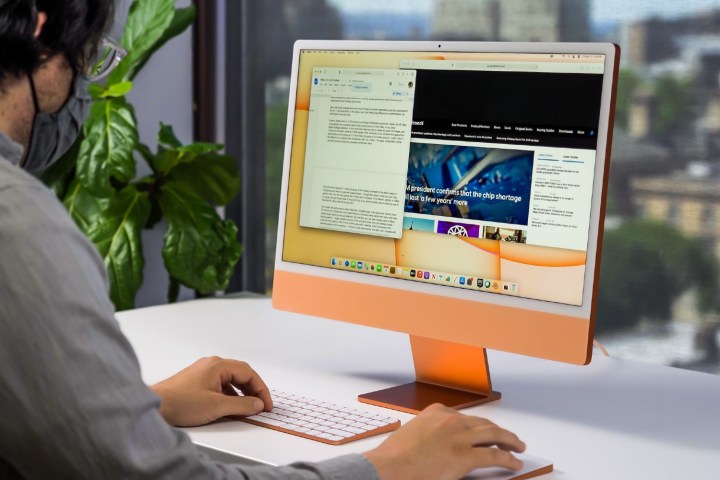
You won’t be surprised to hear that the new iMac’s display looks incredible. It’s a stunningly sharp display that looks clear from every angle and will blow you away with how bright it can get.
It’s “4.5K,” or 4480 x 2520 resolution. In a 23.5-inch screen, that makes for an unbelievably sharp image. You can put your face right up to the screen and not see a single pixel. It’s the same pixel-per-inch measurement as the 27-inch 5K iMac, but this screen is even brighter. I measured it at 527 nits at max brightness, which is slightly ahead of its bigger sibling, and brighter than most monitors you can buy.
I rarely found myself turning it up over 75%, but when working next to a window or under fluorescent lights, I’ll take every nit I can get.
The display of the 24-inch iMac is a winner when it comes to color.
It should be noted that the 24-inch iMac does not include the option for the “nano-texture glass” upgrade, which is Apple’s specialized matte finish to minimize glare. The 24-inch iMac is a glossy screen, but I found it to be shockingly effective at reducing reflections.
The 24-inch iMac is also a winner when it comes to colors. It hits 100% in sRGB and 90% in AdobeRGB, which matches the 27-inch 5K iMac and Microsoft Surface Studio 2, and is among the best color coverage you’ll find on a larger screen.
The display of the HP Envy All-in-One 32 is the only competitive PC to beat the iMac in this category. Its screen is brighter at 600 nits and has a wider contrast ratio, which is the only aspect of the iMac display that’s slightly lacking.
That’s not something you’ll feel while using the 24-inch iMac, though, whether you’re working or watching videos. Of course, you might miss the extra screen real estate if you’re coming from the 27-inch iMac, but it’s a massive improvement over the 21.5-inch iMac. Those two extra inches make this iMac just big enough to get by in 2021.
Performance
The 24-inch iMac uses the M1 processor. And yes, that means it uses the exact same chip as the Mac mini, MacBook Pro, MacBook Air — and now even the iPad Pro. If you’re familiar with how good the M1 already is in those devices, there’s nothing that will surprise you too much here. If you’re worried about the idea of a mobile chip in a desktop, let me put those doubts to rest now. The M1 iMac is very powerful.
The 24-inch iMac is the most powerful implementation of the M1 so far — at least, the configuration I tested was. It’s not by a lot, though. We’re talking about a 3% increase in multi-core performance in benchmarks like Cinebench R23 over the MacBook Pro and Mac mini.

The actual 8-core CPU is actually the same across all the configurations, but the place for upgrades is in the graphics. The configuration I tested out, which opens up the orange, yellow, or purple colors, came with the 8-core GPU, along with 16GB of RAM and a 1 terabyte SSD. That comes in at $2,228 and is quite an upgrade over the $1,299 base model.
With this particular GPU, though, Apple includes a beefed-up cooling solution, with two fans instead of just one. Not that you can ever really hear them spin up. It’s basically silent throughout usage, except when you’re running heavier tasks, specifically ones that stress the CPU. A new series of small vents are situated below the screen for exhausting hot air.
To see what the 24-inch iMac could do in more real-life tests, I used two benchmarks — the Blender benchmark, which is a popular 3D-modeling application, and the Pugetbench Adobe Premiere Pro benchmark. Now remember, Premiere Pro is still running in Rosetta 2 emulation, meaning it’s not a native universal app yet. And yet, the 24-inch iMac flew through the benchmark. Its GPU score was 23% higher than the Mac mini we reviewed earlier this year, despite having the same 8-core GPU. That’s what the improved cooling and airflow will do for ya.
The M1 iMac is nowhere near as fast as the Core i9 27-inch iMac.
The playback score is particularly impressive, as is the ability to manage multiple 4K streams simultaneously without skipping a frame. It is not at all a bad little video-editing machine, but you’ll still find yourself waiting for exports. The Core i9 27-inch iMac is 77% faster at exporting video than the M1 — so that should give you an idea of what kind of performance we’re talking about here.
Now, that could change quite a bit once Premiere and other applications get fully optimized for the M1 — we know that’s in the works, and it will make a big difference on performance, but we’ll have to wait and see.
It was a similar story in a CPU-bound run through the Blender benchmark. Again, the M1 iMac is not anywhere near as fast as the Core i9 27-inch iMac or any other higher-wattage desktops. It took more than twice as long to render the same 3D images, and in some of the tests, it was upwards of 66% slower. Now, if you compare this against the performance of the previous 21.5-inch iMac, it’s going to run circles around it. I didn’t have it in the office to do a side-by-side comparison with, but the 21.5-inch base configuration was still running a dual-core processor and options for a fusion drive.

And what about gaming on the iMac? It isn’t exactly a strength of the iMac outside of iOS games and what you get with Apple Arcade — though that doesn’t mean you can’t play games at all. You can play games like Fortnite and Civilization VI at Medium settings in 1080p and get frame rates of around 50 frames per second (fps) or so, which is pretty close to what you get on the other M1 Macs with the 8-core GPU.
But overall, the performance doesn’t feel like a breakthrough in the same way that the initial M1 launch did. Putting that much performance in the exact same laptop form factor was what made people stand up and pay attention. But with this one, we were already used to iMacs being powerful. Outside of the HP Envy All-In-One 32, the 27-inch iMac was one of the only all-in-ones with a full desktop chip inside. In terms of raw performance, the 24-inch iMac can’t compete with that yet.
And it was never meant to, at least not directly. That’s why it comes with only 16GB of RAM, and it barely has any ports.
The 24-inch iMac is a new form factor for Apple. It’s the first real product that’s been designed from the ground up with the efficiency of the M1 in mind. They’ve never made an iMac this thin, and like it or not, they’re doing something entirely new here. With that considered, it’s astounding just how much performance Apple has squeezed out of this system.
Webcam and speakers

The M1 touches far more than just the raw processor and graphics performance. Apple now has access to every component of the system: The webcam, the speakers, the microphones, Touch ID, and much more. The M1 controls all of this and lets Apple improve those quality-of-life elements in a way that wasn’t possible before.
Let’s start with the FaceTime webcam. It’s 1080p, which is good and is technically an improvement over the 21.5-inch iMac. Actually, it’s the same exact camera that’s in the 27-inch iMac and the now-extinct iMac Pro — but Apple says it’s even better this time around. And it is. Using them side-by-side, the 24-inch iMac handles lowlight performance better, brightening up skin tones and highlights without blowing out backgrounds. The iMac ensures that you’ll never consider buying an external webcam. It’s killer.
The iMac ensures that you’ll never consider buying an external webcam.
I have similar comments about the speakers. This is, technically, a new audio solution. It features a six-speaker setup, with downward-firing sound being pushed out below the screen. They’re loud and crisp, the stereo separation feels immersive, and there’s even plenty of bass in the mix — and honestly, whether you’re listening to music or watching a movie, this a great audio solution that doesn’t require external speakers or headphones.
The key to the great sound? The speakers use the force-canceling subs that were originally put in the 16-inch MacBook Pro, which allows the system to drive far more air volume from these tiny little speakers. Again, side by side with the 27-inch iMac, they sound a bit more full-bodied.
It’s these features, which include the super-sharp 4.5K resolution screen, which is the exact same pixels per inch as the 27-inch model. That makes the base configuration of the iMac in particular quite attractive. You’re paying a $600 difference between the Mac mini and this 24-inch iMac. When you consider what that buys you, it’s a pretty solid deal.
Apple could easily sell this monitor alone for at least $600, but of course, you also get the great speakers and the webcam and all the rest of the hardware that make this a complete package. I’m not saying it’s cheap, but the days of Macs being the overpriced luxury PCs just doesn’t really fit the bill anymore.
Peripherals
The 24-inch iMac includes two accessories out of the box: The Magic Mouse and the Magic Keyboard. The Magic Keyboard has finally received Touch ID, a highly requested feature. Up until this point, the iMac didn’t have any of the security features found on other Apple devices, requiring you to use an old-fashioned password to log in and make purchases online.
Touch ID finally brings it up to speed, and it works great. The only problem is that Apple requires you to pay an extra $50 if you’re buying the base configuration. I’m still waiting for Face ID, but Touch ID is a bare minimum.
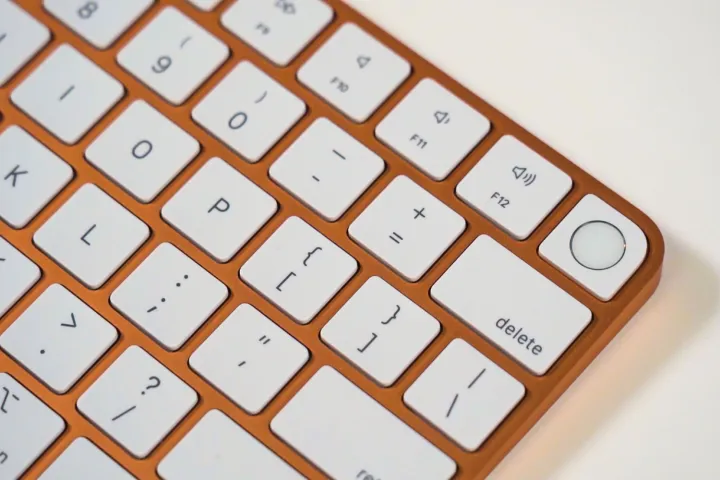
The Magic Mouse has been slightly redesigned, but not in the way I’d hoped. Like the Magic Keyboard, the Magic Mouse now has been color-matched to the tone of your iMac. The unfortunate shape of the mouse remains, though, making it thoroughly uncomfortable to use for more than an hour or so.
Worst of all, it can’t be charged and used at the same time.
The accessory Apple makes, the Magic Trackpad, is nearly identical to its previous model. The only difference is slightly rounded corners and the new color options.
Our take
A lot of power users and creative professionals will be tempted by the 24-inch iMac. If you primarily rely on Apple’s own software ecosystem, or on apps already optimized for the M1, you’ll be very happy with your purchase.
Meanwhile, the size of the screen, limited ports, and lack of discrete graphics will leave plenty of room for a true Pro-level iMac down the road. The 24-inch iMac has a much wider intended audience — and for them, the iMac is a near-perfect all-in-one computer.
Are there any alternatives?
The primary alternative is the 27-inch 5K iMac. The top-of-the-line model is still more powerful in tasks like video exporting, and the configurations are far more versatile.
The HP Envy All-In-One 32 is the best alternative on the Windows side of the spectrum. It’s not as sleek, but has a powerful desktop Intel chip inside, along with Nvidia RTX graphics.
How long will it last?
Nothing in the 24-inch iMac is user-upgradable. So long as you configure it to your needs to start with, this iMac should last you upwards of a decade. Apple is good about supporting older Mac systems with software updates, and the M1 will continue to be a solid performer many years after the day you buy it.
Should you buy it?
Absolutely. The iMac is really good at being the iMac for everyone. So long as you can forgive the white bezels, everyone except the most power-hungry creative professionals will be delighted by what it offers.
Editors' Recommendations
- The 5 best iMac alternatives in 2024
- Best Apple deals: Save on AirPods, Apple Watch, iPad, MacBook
- Apple just dashed our iMac hopes and dreams
- How to watch Apple’s ‘Scary Fast’ Mac launch event if you missed it
- Everything announced at Apple’s ‘Scary Fast’ event: iMac, M3, and more

